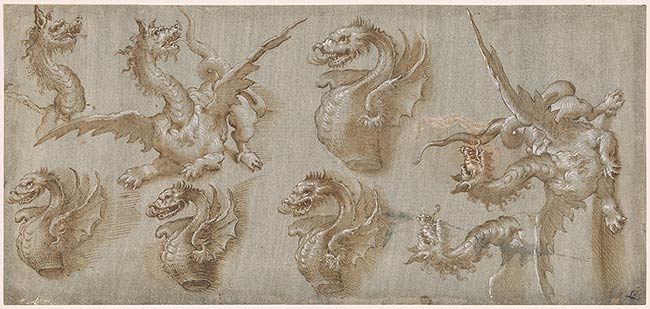

The motifs are copied from two different prints by Agostino Carracci. Most of the recto and verso studies are taken from Agostino Carracci’s etching Apollo Saving the People of Delphi from the dragonlike Python, executed around 1589 to 1592, an impression of which is also in the collection of the Morgan Library & Museum (acc. no. 660; Bartsch,18: 107, no. 122). The foliage on the verso is an atmospheric rendering of the trees in the background, omitting some of the more detailed branches, especially those behind the Python. The full-length animals on the recto and the two adjacent dragon heads all refer to the Python in the print while the four half-length dragons, more heraldic in appearance, are taken from Agostino’s print of the Coat of Arms of Giacomo Boncompagni, Marchese of Vignola, published in ca. 1582-85 (Bartsch, 18: no. 165 (126); 39: 206, no. 165; Bohn, 39: 156). Agostino’s etching Apollo and the Python records one of six intermezzi,or performances given during the intervals of the play La Pellegrina, staged in Florence in 1589 on the occasion of the marriage of Ferdinand I de’ Medici and Christina of Lorraine. Conceived by Giovanni de’ Bardi and performed with costumes and machines designed by the artist Bernardo Buontalenti, the intermezzi were intended to provide interludes of spectacular theatrics with rich costumes, elaborate stage machinery, and striking dramatic effects. All six intermezzi were recorded in prints - two by Agostino, who also etched The Harmony of the Spheres - and four by Epifanio d’Alfiano. For The Harmony of the Spheres likely as not Agostino worked after a drawing by Andrea Boscoli in the Uffizi, rather than after the original design by Buontalenti in the Victoria and Albert Museum, London. The situation for Apollo and the Python may have been similar though no related drawing by Boscoli is known - only Buontalenti’s design survives (inv. E 1188-1931; Victoria and Albert Museum).
Watermark: none.
Both recto and verso are studies for details of stage design of "Apollo and the Python", one of the six Florentine Intermezzi of 1589.
Formerly attributed to Bernardo Buontalenti, Florence 1531-1608 Florence.
Inscribed at lower left, in pen and brown ink, "Ag. Carracci" (almost completely effaced); on verso, at upper center, in graphite, "Celini".
Anonymous, Italian School, 16th cent., Alternate attribution.
Anonymous, Italian School, 17th cent., Alternate attribution.
Buontalenti, Bernardo, 1536-1608, Formerly attributed to.
Lucas, Lionel, 1822-1862, former owner.
Lucas, Claude, former owner.
Kirstein, Lincoln, 1907-1996, former owner.
Iowa City 1951, no. 24a; Fellows Report 1961, 79-81; Review of Acquisitions, 1969, 150; Madison 1973, no. 38; Washington 1979, 270, n. 3; Blumenthal 1986, 91, 117, no. 189.
Adams, Frederick B., Jr., comp. Eleventh Report to the Fellows of the Pierpont Morgan Library, 1961. New York : Pierpont Morgan Library, 1961, p. 79-81.
Pierpont Morgan Library. Review of Acquisitions, 1949-1968. New York : Pierpont Morgan Library, 1969, p. 150.
